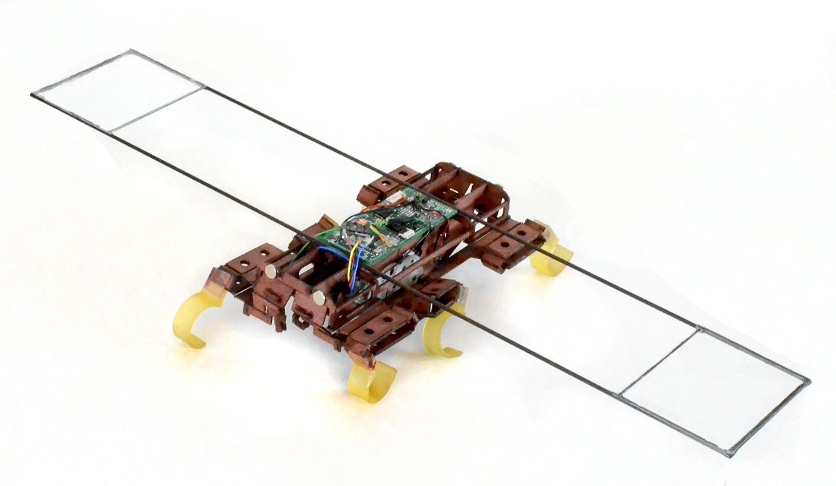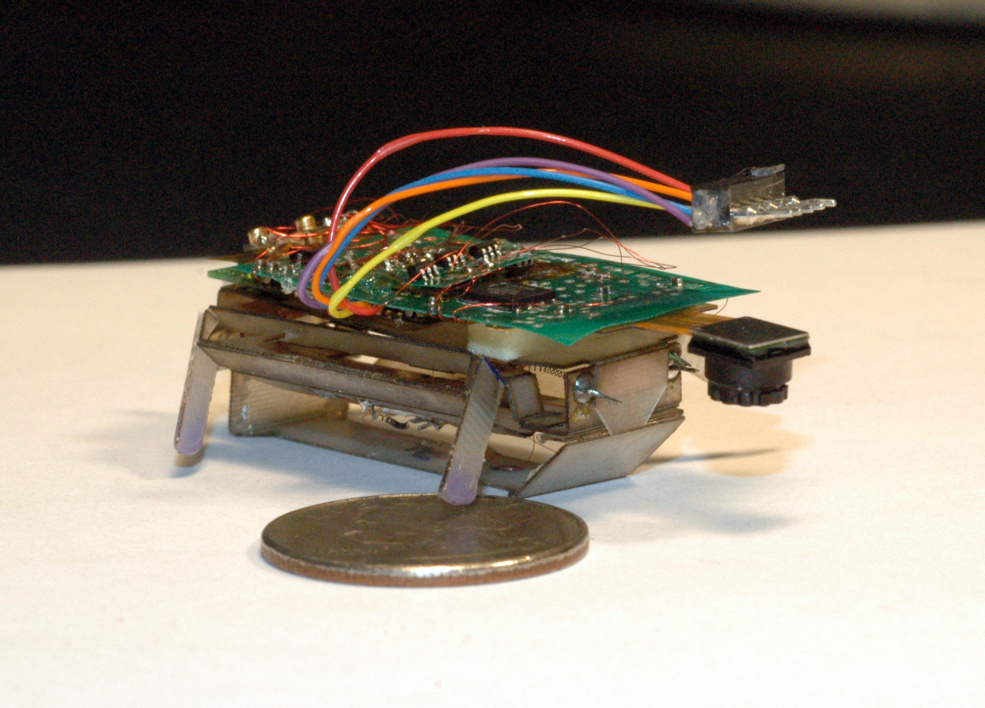| HOME |
| PUBLICATIONS |
| Biomimetic Millisystems Lab |
| Why legged robots? |
|
Legged systems
provide some key performance
advantages compared to wheeled systems. In a legged system the feet
are not continually in contact with the ground, whereas wheels require
a continuous path of support. This enables legged organisms and
robots to traverse challenging terrain. Some legged systems
(biological and man-made) can overcome obstacles that are more than
three times taller than the hip height of the system while wheels are
limited to obstacles no higher than one radius. Finally, and perhaps
most interesting is the dynamic behavior of legged organisms seen in
nature. Many legged animals exhibit dynamically, self-stabilizing
behavior. That is, the passive mechanical properties of the systems
are tuned to naturally reject disturbances which might otherwise cause
unstable behavior in the system.
|
| Recent
Results |
|
|
Bidirectional, thin-film repulsive-/attractive-force
electrostatic actuators for a crawling milli-robot
(July 2018)
RAFA is a new thin-film electrostatic actuator which works in both attractive and repulsive modes. The two-layer actuator generates electrostatic pressures up to 156 Pa in repulsion and 352 Pa in attraction when operating at 0 to 1.2 kV. RAFAR, a 132 mg tethered milli-robot, crawls at 0.32 mm/s with anisotropic friction feet. E.W. Schaler, L. Jiang, C.Lee, and R.S.Fearing, (MARSS 2018) . (MARSS 2018 Best Student Paper Award.) |
 |
| Coordinated
Launching of an Ornithopter with a Hexapedal Robot
(May 2015) We develop a cooperative launching system for a 13.2 gram ornithopter micro-aerial vehicle (MAV), the H2Bird, by carrying it on the VelociRoACH. We determine the necessary initial velocity and pitch angle for take off using force data collected in a wind tunnel and use the VelociRoACH to reach these initial conditions for successful launch. Rose et al. (IEEE ICRA May 2015) video |
 |
|
Running beyond the bio-inspired regime
(May 2015)
The X2-VelociRoACH is a 54 gram experimental legged robot which was developed to test hypotheses about running with unnaturally high stride frequencies. It is capable of running at stride frequencies up to 45 Hz, and velocities up to 4.9 m/s, making it the fastest legged robot relative to size. Haldane and Fearing ( IEEE ICRA May 2015) video |

|
|
Anisotropic Leg Spines for Increased Traction
(May 2015)
Collapsible leg spines found on insects and spiders provide a passive mechanism for increased traction while running over complex terrain. Spiny feet for VelociRoACH reduced dimensionless Cost of Pulling by an order of magnitude while robot speed while pulling load increased by 50%. Lee and Fearing ( IEEE ICRA May 2015) video |

|
|
1STAR: 1 actuator STeerAble Robot
(June 2014)
We present a novel dynamic gait to control in-plane locomotion (forward, back, clockwise and counter clockwise rotations) of a compliant legged hexapedal robot using a single actuator. The gait exploits the compliance disparity between alternate stance tripods, to generate rotation by controlling the acceleration of the robot. Zarrouk and Fearing ( IEEE ICRA June 2014) movie (Finalist for best conference video) |


|
|
Roll oscillation modulated turning
(June 2014)
A new dynamic turning mode in legged robots is demonstrated, which uses a phase-locked gait to excite coupled height and roll oscillations. A modified robot with enhanced roll oscillations turned at 206 deg/sec at a speed of 0.4 m/s. Haldane and Fearing (IEEE ICRA June 2014) video |


|
|
Detection of Slippery Terrain with Picket Robot
(June 2014)
Experiments conducted with StarlETH (ASL, ETH Zurich) and UCB VelociRoACH using joint localization detected slippery terrain with 92% accuracy. Haldane et al. ( IEEE ICRA June 2014) video |

|
|
Aerodynamic Steering SailRoACH (Oct. 2013) SailRoACH uses aerodynamic forces on its tail to turn, achieving at 1.2 meter radius turn while running at 1.6 meters per second. Scaling laws work favorably for this turning mode for fast running small robots. Kohut et al. (IEEE IROS Nov. 2013) movie |
 |
|
A Sprawl Tuned Autonomous Robot
(Feb. 2013) This robot has a variable leg sprawl angle in the transverse plane to adapt its stiffness, height, and leg-to-surface contact angle. Contact angle and normal contact forces are substantially reduced when the sprawl angle is low, and the velocity increases over smooth surfaces, with stable running at all velocities up to 5.2 m/s. Zarrouk et al. ICRA 2013. Movie |
 |
|
Animal-inspired Design and Aerodynamic Stabilization of a Hexapedal Millirobot
(Jan. 2013) The VelociRoACH is a 10 cm long, 30 gram hexapedal millirobot capable of running at 2.7 m/s, making it the fastest legged robot built to date, relative to scale. Dynamic similarity technique combined with aerodynamic damping provides stability at high speeds. D. Haldane et al. IEEE ICRA 2013. Movie |
 |
| Dynamic Climbing of Smooth
Surfaces (Oct.
2012) Dynamic climbing of near-vertical surfaces introduces reaction forces which require greater normal adhesion to prevent falling. Dynamic climbing on a 30 degree slope succeeds at 12 Hz leg rate, but only 4 Hz on a 70 degree slope. Birkmeyer, Gillies, Fearing IROS Oct 2012 movie1 movie2 |
 |
| Rapid Inversion:
Running Animals and Robots (June
2012) Cockroaches and geckos can escape when running by swinging under a ledge in a pendulum like motion. The DASH robot, with a special foot attachment, can also swing in a similar manner. Mongeau et. al PLoS June 2012 |
 |
| 6 legged TAYLRoACH (July 2012) The 100-mm scale Hexapedal robot TAYLRoACH can rapidly maneuver with 90 degrees turns while running. Kohut et al. CLAWAR, Baltimore, July 2012. Tail Maneuver movie |

|
| OctoRoACH with Tail (May 2012) The 100-mm scale OctoRoACH robot can turn using differential drive at 100 degrees per second, or with a dynamic tail with peak turn rates of 400 degrees per scond. Pullin et al. ICRA 2012 movie |
 |
| DASH+Wings:
Wing
Assisted Running (Oct. 2011) DASH+Wings is a small hexapedal winged robot that uses flapping wings to increase its ground locomotion capabilities. The wings increase climbing slopes and stability, but do not provide enough thrust for flight. A wing assisted running robot and implications for avian flight evolution. Bioinspiration and Bioimetics |
 |
|
OctoRoACH:Dual Drive MilliRobot (Sep. 2011) The OctoRoACH robot has a mass of less than 30 grams, and includes the ImageProc CPU with gyro, accelerometer, radio and camera, is capable of locomotion in rough surfaces. Robot designed by A. Pullin. Pullin et al. ICRA 2012 |
 |
| CLASH:
Climbing loose vertical cloth (Sep. 2011) The CLASH robot has a mass of 15 grams, and is capable of climbing a loose cloth surface at 15 cm per second using a simple passive claw mechanism and a coupled in-plane leg drive system. (Birkmeyer et al. IROS 2011) and movie |
 |
| MEDIC Millirobot with
body-supported climbing
(Dec. 2010) The Medic robot has a mass of 5.5 grams, and is capable of positioning within 1 mm using static SMA drive. The robot includes camera and wireless. (Kohut et al. ICRA 2011.) |
 |
| Dynamic turning by
modulating leg stiffness
(Sep. 2010) The dynaRoACH robot has mass of 24 grams and is capable of running at 14 body lengths per second. By changing leg stiffness, the robot can execute a 90 degrees turn in 5 leg strides. BioRob 2010 Movie (slow motion) Movie (real time) |
 |
| RoACH 2.0 and DASH on
Granular Media (Apr. 2010) Joint work with Goldman lab at GeorgiaTech to measure cost-of-transport on granular media shows 5-30 J/kg-m at 6-10 body lengths per second. SPIE 2010 |
 |
|
DASH 16 gram Hexapedal
Robot (Oct. 2009)
Using compliant fiber board as
structural material, and a single main driver motor, the DASH robot is
capable of 15 body lengths per second on flat surfaces. The structure
is resilient and survives ground impact at terminal velocity of
10
meters per second.
DASH: A Dynamic 15g Hexapedal Robot, IROS 2009. Video (Youtube). |
 |
|
The miniRoACH Robot (2008)
In
the Biomimetic Millisystems Lab we have combined our expertise in
building millirobots with an interest in legged systems to build what
we believe is the smallest untethered, legged robot to date - a 2.5
gram legged robot called the Robotic Autonomous
Crawling Hexapod
(RoACH). This robot makes use of the
Smart Composite
Microstructures fabrication process
and integrated shape memory alloy (SMA) wire actuators. All power,
control, and communication electronics are carried onboard and the
entire robot is powered with a 20maHr Lithium-polymer battery from the
Full River corporation.
movie
|
 |
|
Scaled prototyping of a legged millirobots
Using
commonly
available, inexpensive
materials, it's possible to create folded prototypes of legged robots
with as many as 60 joints in about 1 hour. The prototypes can then be
actuated with DC motors or other types of actuators such as shape
memory alloy wire as shown in the photo to the right. Folding Prototyping Fast scale prototyping for folded millirobots, ICRA 2008 |
 |
